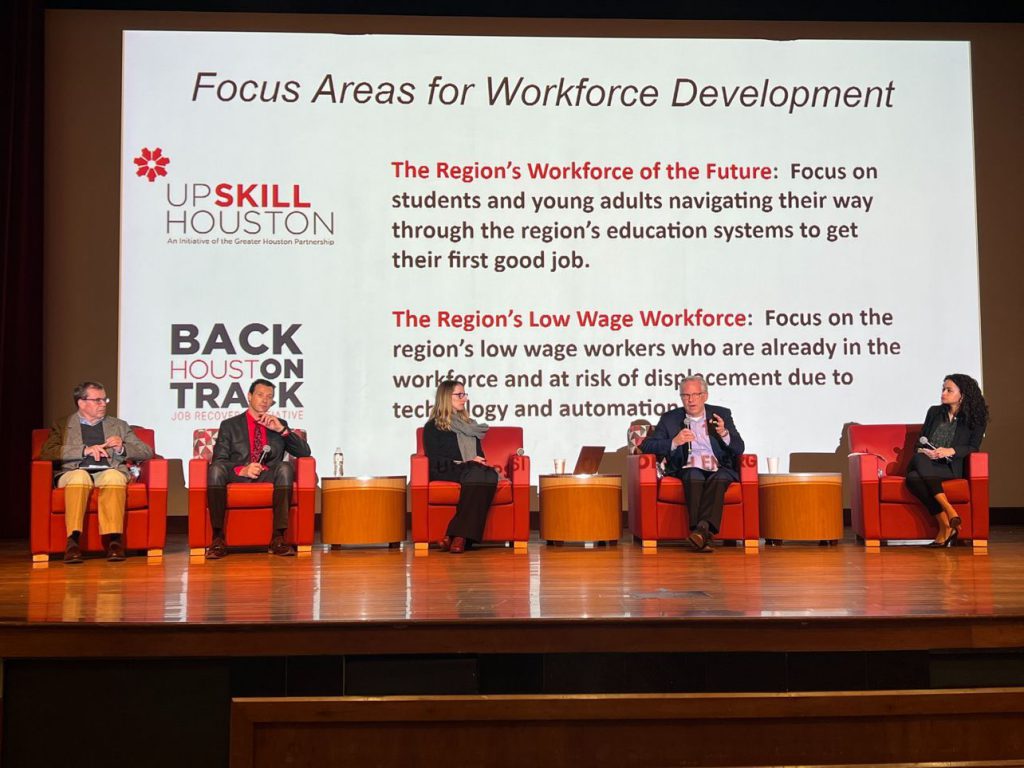
Energy Workforce & Technology Council Senior Director for Energy Policy Maria Suarez-Simmons participated on a panel hosted by UH Energy at the University of Houston. The panel, which focused on energy workforce development, was part of UH Energy’s NetZero Texas by 2050 symposium.
The NetZero Texas by 2050 presented results from the study on five focus areas: CCUS, electric grid, transportation, financial incentives and workforce development. Energy Workforce Member Company SLB was featured on the CCUS panel with representation by Dianne Ralston, Chief Legal Officer.
On the workforce development panel, Suarez-Simmons discussed the energy services sector’s challenges in a tight labor market, what is needed to recruit the next generation of workers, and the overall need for investment in workforce development, recruiting, upskilling and reskilling. She said global energy demand is growing, leading to numerous career opportunities in the energy industry today and in the years to come. The opportunities are leading to a more diverse workforce with a variety of skills, including an ever-growing reliance on new and innovative technologies.
Panelists included Pablo M. Pinto of the Hobby School of Public Affairs; Peter Beard of the Greater Houston Partnership; C. T. Bauer College of Business (University of Houston) Dean Paul A. Pavlou; and was moderated by Gail Buttorff, Hobby School of Public Affairs.
Several of the findings on workforce development within the NetZero Texas by 2050 study are relevant to Energy Workforce membership including:
- The state stands to gain the most in workforce development and economic impacts under scenarios where an all-of-the-above energy strategy is followed, as against considerably prioritizing capacity additions in either renewables and storage or liquids fuels and CCUS. The highest gains for the workforce and economy are achieved when the capacity addition of renewables is balanced with that of liquid fuels, biomass, hydrogen, CCUS and CDR.
- The CCUS sector can potentially grow to support five times the current oil and gas workforce in the state if it receives policy support and incentives that allowed early gains in oil and gas in the 1940s through 1980s and wind energy since the early 2000s.
- The sector can be supported with a highly skilled workforce from the coal, oil and natural gas sectors where jobs will be lost through the transition. Ensuring transferability of skills, reskilling and upskilling will ensure that the current workforce is not under-utilized and the economic decline from the lost jobs can be minimized.
Energy Workforce thanks UH Energy for the invitation to discuss how Energy Workforce advances the sector and those within it through leadership and development programs. More information on these training programs can be found online or by contacting Vice President Programs & Events Peggy Helfert.
Maria Suarez-Simmons, Senior Director Energy Policy, writes about industry-specific policies for the Energy Workforce & Technology Council. Click here to subscribe to the Energy Workforce newsletter, which highlights sector-specific issues, best practices, activities and more.




